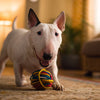How Much Raw Food to Feed Your Dog: A Comprehensive Guide
- Houndsy
Table of Contents
- Introduction
- Understanding the Basics of Raw Feeding
- Calculating the Right Amount of Raw Food
- Common Concerns and Misconceptions
- Transitioning to a Raw Diet
- Conclusion
- FAQ
Introduction
Did you know that over 70% of pet owners are considering or have already switched to a raw food diet for their dogs? This trend reflects a growing awareness of the benefits of feeding our furry companions a diet closer to what they would naturally consume in the wild. While the idea of feeding raw can be enticing, it also raises a critical question: how much raw food should we feed our dogs?
The significance of this question lies in our pets' health and well-being. A balanced and nutritious diet is essential for maintaining a healthy weight, strong immune system, and optimal energy levels. However, determining the appropriate portion size can be challenging, as it varies widely based on factors such as age, weight, activity level, and individual metabolism.
In this blog post, we will explore everything you need to know about how much raw food to feed your dog. We will cover essential guidelines, common misconceptions, and practical tips to help you transition smoothly to a raw diet. By the end of this article, you will possess a clear understanding of how to calculate the right amount of raw food for your beloved pet and how to monitor their progress effectively.
So, let's dive into the world of raw feeding and discover how we can enhance our dogs' lives through their diet!
Understanding the Basics of Raw Feeding
What Is Raw Feeding?
Raw feeding, in its simplest form, involves providing your dog with uncooked meats, bones, organs, and, in some cases, fruits and vegetables. This approach is based on the premise that a diet mimicking what dogs would have eaten in the wild promotes better health and vitality. There are various raw feeding methods, including:
-
Biologically Appropriate Raw Food (BARF): This method includes raw meaty bones, organ meats, and a small proportion of fruits and vegetables. Its goal is to replicate a dog's natural diet as closely as possible.
-
Prey Model Raw (PMR): This approach aims to mimic the natural prey of dogs, incorporating whole animals or parts of animals like muscle meat, bones, and organ meat.
Benefits of Feeding Raw
Transitioning to a raw diet can offer numerous benefits, including:
-
Improved Digestion: Raw diets are generally easier for dogs to digest, leading to less bloating and fewer gastrointestinal issues.
-
Healthier Coat and Skin: Many dog owners report shinier coats and healthier skin after switching to raw food, thanks to the nutrient density of raw meats.
-
Fresher Breath and Cleaner Teeth: Chewing on bones can help reduce plaque build-up and lead to better oral health.
-
Increased Energy Levels: A balanced raw diet can provide dogs with the energy they need for their daily activities.
Factors Influencing Raw Food Portions
When determining how much raw food to feed your dog, several factors need to be considered:
-
Weight: The ideal body weight is crucial in calculating portion sizes. An overweight dog will require less food, while an underweight or high-energy dog may need more.
-
Age: Puppies generally require more food relative to their size compared to adult dogs due to their rapid growth.
-
Activity Level: Active dogs burn more calories and will typically need larger portions than sedentary dogs.
-
Health Status: Dogs with certain health conditions or dietary restrictions may require specific feeding guidelines.
Calculating the Right Amount of Raw Food
General Guidelines for Adult Dogs
As a starting point, we can use the general rule of thumb that suggests feeding adult dogs between 2% to 3% of their ideal body weight daily. This percentage can vary based on the factors mentioned above.
For example:
- For a 50-pound dog, the calculation would be:
- 2% of 50 lbs = 1 lb of raw food daily
- 3% of 50 lbs = 1.5 lbs of raw food daily
Adjusting Portions Based on Activity Level
-
Active Dogs: If your dog is highly active or works as a service animal, you might consider feeding at the higher end of the range (3% of their ideal body weight).
-
Less Active Dogs: Conversely, if your dog is older, less active, or overweight, starting at 1.5% to 2% of their ideal weight would be wise.
Puppy Feeding Guidelines
Puppies have different nutritional needs compared to adult dogs. It's generally recommended to feed puppies around 5% to 10% of their current weight, divided into multiple meals throughout the day (typically three to four meals for younger puppies).
For example:
- For a 10-pound puppy, you would feed:
- 5% of 10 lbs = 0.5 lb of raw food daily
- 10% of 10 lbs = 1 lb of raw food daily
Monitoring and Adjusting Portions
Once you start feeding raw food, it is vital to monitor your dog's weight and overall health closely. Here's how to ensure you're on the right track:
-
Weight Checks: Weigh your dog regularly (once a week is ideal) to track any significant changes in weight.
-
Physical Assessment: Assess your dog's body condition. You should be able to feel their ribs without excess fat covering and see a defined waist when looking from above.
-
Adjust as Needed: If your dog is gaining too much weight or losing weight rapidly, adjust the food portion accordingly.
Common Concerns and Misconceptions
Will My Dog Get Enough Nutrients?
One of the primary concerns pet owners have about raw feeding is whether their dog will receive adequate nutrition. A well-planned raw diet can provide complete nutrition, but it requires careful consideration of the balance of proteins, fats, vitamins, and minerals.
- Consult a Veterinarian: Always consult with your veterinarian or a pet nutritionist when transitioning to a raw diet. They can help you formulate a balanced meal plan tailored to your dog's specific needs.
Is Raw Food Safe?
Handling raw food comes with inherent risks, such as exposure to harmful bacteria like salmonella. Here are some safety tips:
-
Hygiene: Wash your hands thoroughly after handling raw meat and clean all surfaces, utensils, and feeding bowls.
-
Storage: Store raw food in the refrigerator or freezer to maintain freshness and prevent spoilage.
Can I Mix Raw and Kibble?
While some pet owners choose to mix raw food with kibble, it is generally not recommended due to potential digestive issues. If you decide to transition to raw food, it’s best to do so gradually and completely rather than mixing.
Transitioning to a Raw Diet
Steps for Transitioning
Transitioning your dog to a raw diet should be done gradually to minimize gastrointestinal upset. Here’s a simple approach:
-
Days 1-3: Start by introducing small amounts of raw food while continuing to feed their regular kibble. Aim for a ratio of 25% raw to 75% kibble.
-
Days 4-7: Increase the raw food portion to 50%, maintaining the same ratio of kibble.
-
Days 8-14: Continue increasing the raw food amount while decreasing kibble until your dog is fully transitioned to a raw diet.
Monitoring Digestive Health
As you transition, keep an eye on your dog’s stool consistency and overall demeanor. If you notice any signs of distress, such as diarrhea or vomiting, consider slowing down the transition process.
Conclusion
Feeding your dog a raw food diet can be a rewarding way to improve their health and vitality. By understanding how much raw food to feed your dog and adjusting portions based on their individual needs, you can create a balanced and nutritious diet that supports their overall well-being.
As we’ve explored in this guide, the key factors to consider include your dog's weight, age, activity level, and health status. With this knowledge, you can confidently make informed decisions about your dog's diet and feeding routine.
If you're looking for a convenient and aesthetically pleasing way to streamline your dog's feeding process, be sure to explore the Houndsy Kibble Dispenser. It combines innovative design with functionality, making mealtime a breeze. Order Now to elevate your dog feeding experience!
FAQ
How much raw food should I feed my puppy? Feed your puppy about 5% to 10% of their current weight, divided into multiple meals throughout the day.
What is the best way to calculate raw food portions? A general guideline is to feed adult dogs between 2% to 3% of their ideal body weight daily, adjusting based on activity level.
How can I ensure my dog is getting balanced nutrition on a raw diet? Consult with a veterinarian or a pet nutritionist to create a balanced meal plan that meets your dog's nutritional needs.
What should I do if my dog is gaining too much weight on a raw diet? Monitor their weight regularly and adjust their food portions accordingly, typically reducing the amount slightly.
Is it safe to feed my dog raw meat? Yes, but take proper hygiene precautions when handling raw meat and ensure the food is stored correctly to prevent spoilage.












